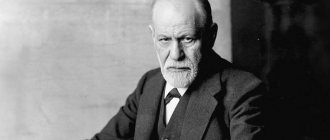The inner world of a person, even if he is absolutely mentally healthy, is not at all homogeneous. A large number of different “I” lives in his soul, which can be called subpersonalities or characters. Of course, it is quite difficult to imagine that a person consists of several parts. After all, healthy people do not talk to themselves and feel that their soul is whole. However, Freud's theory of the "Id", "I" and "Super-Ego" proves that the polyphony of internal characters still exists. Moreover, they are elements of the structure of the human psyche, just as the set of organs of the body is a living organism. Let's consider the theory of "I", "It" and "Super-Ego" and what psychoanalysis is.
Definition of the concept
For centuries, the greatest minds of mankind have been trying to study the structure of human personality. However, only psychoanalytic theory, created at the end of the 19th – beginning of the 20th century, made it possible to obtain answers to many questions.
The ideas of this direction had a significant influence on literature, art, medicine, as well as on many areas of science that are associated with the study of man. At the same time, psychoanalysis became the only discipline that became so widely known.
The founder of this trend is Sigmund Freud (1856–1939). It was his ideas that formed the basis, and after some adjustments and additions, formed psychoanalysis. This is a concept that includes three elements:
- theory of psychopathy and personality;
- the method by which the treatment of personality disorders is carried out;
- a way to study a person’s feelings and unconscious thoughts.
History of creation
The psychoanalytic method was developed by Freud based on the experiments of the Viennese doctor Joseph Breuer. This doctor was treating a patient suffering from a severe form of hysteria. In order to understand the causes of deep mental turmoil, Breuer decided to use hypnosis. It was this method that forced the patient to talk about the circumstances that preceded the illness. As it became clear, most of the symptoms of hysteria were the result of affective experiences that the girl experienced while on duty at the bedside of her beloved, seriously ill father. The doctor made his patient not only remember this period. During his sessions, the girl once again experienced her affective states. As a result, all symptoms of the disease disappeared. Breuer called the treatment method he created catharsis, which translated from Greek means “purification.”
Based on such experiments, Freud suggested that the mental area is not at all reducible to the conscious. Often the true motives of a person’s behavior are far beyond his consciousness. Subsequently, Freud began to use the cathartic method himself. He did this not even in the patient’s hypnotic state, but in a normal one. The results of such studies have convincingly proven that the human psyche has a diverse and complex structure.
Before Freud, doctors could not explain some clinical signs of hysteria in terms of physiological factors. After all, in patients, one part of the body completely lost sensitivity, and the areas adjacent to them continued to feel various stimuli. In addition, before Freud created the theory of “I,” “Id,” and “Super-Ego,” it was impossible to explain the behavior of people that took place in a state of hypnosis. That is why the scientist suggested that only part of the processes occurring in the psyche is a reaction of the central nervous system.
We are publishing a report by psychoanalyst Gleb Napreenko, read as part of the reading meetings of the 7th seminar of Jacques Lacan “Ethics” as part of
the Clinical Program .
One of the reasons for this report was a fragment from the first chapter of the 7th Lacan seminar: “It’s me
, which must appear where
(something) was,
and which
analysis
teaches us to measure, is nothing other than that very thing whose roots are already given to us in that Self that asks the question of what it wants. It is not just questioned - no, over time, gaining experience, it asks this question itself, and it poses it exactly where those often alien, ruthless, paradoxical imperatives that are offered to it by painful experiences come from. Will he submit or not submit to that duty that he feels within himself as alien, otherworldly, secondary? Should he or should he not obey the imperative of the super-ego - paradoxical, painful, semi-conscious and revealing, insisting on itself more and more as the analytical work progresses and the patient sees that there is no turning back for him? Isn’t his real duty to go, so to speak, against this imperative?”
There is something fundamentally incomprehensible in the imperatives of the Super-Ego. This is not at all the voice of social pragmatism or ordinary common sense. And the need to deal with the incomprehensibility of the demands of the superego is, to one degree or another, a challenge for the subject.
An example of this can be various clinical cases - for example, the case of a teenager who is haunted by imperative auditory hallucinations of his mother’s voice, but who has endowed his pocket toy with a special voice and acts out educational scenes of child-parent relations between it and himself, thereby somehow framing the harsh Super -I.
We can also recall the reproaches of conscience that are familiar to many - in addition to the understandable component, there is something redundant in them, a kind of “too much”, which precisely indicates the involvement of the super-ego in these reproaches.
Freud's predecessor to the concept of the superego is the concept of censorship. Censorship is associated with a certain rift in speech, a rift between the repressed and the expressed, while censorship is thought of as something that opposes the articulation of desire.
The super-ego also contains a certain rift, but things here are more complicated: it is a rift within the law, which cannot be reduced to repression and opposition to the articulation of desire. The super-ego is largely unconscious, and its roots are the same as those of desire.
To understand the difference between the theory of censorship and the theory of the superego, one must keep in mind that for Freud two things changed between them:
- The death drive was introduced in the article “Beyond the Pleasure Principle” - an drive without which it is impossible to imagine the passionate cruelty of the Super-ego;
- A theory of identification was created (primarily in “Psychology of Masses and Analysis of the Human Self,” where, among other things, we are talking about the Ideal of the Self) - which makes it possible to see the origins of the Super-I in identifications.
Freud introduces the concept of the Super-Ego in his work “The Ego and the Id,” where the relationship between the Ego and the Super-Ego is conceptualized through the gap between the Ego and its object (primarily identification) loads.
In The Ego and the Id, Freud roots the superego in identifications of two types, two levels.
Firstly, this is identification associated with a person’s primary dependence on the Other and the risk of being abandoned by him. Lacan will further speak of this dependence as the primary basis of the social connection. We can say that it is at this level that the super-ego is located in the clinic of melancholia. In “The Ego and the Id,” as in “Mass Psychology,” the primary identification for Freud associated with oral (even cannibalistic) incorporation is precisely identification with the father (and not with the mother, as one might think).
Secondly, these are identifications that arise as a result of the Oedipus complex. The conflict between the ego and its loads appears here as a consequence of the conflict in this complex. Freud writes about the two-faced nature of the superego: “The “superego” is not simply a sediment of the first object selections made by the “id”; The “super-ego” also has the meaning of energetically forming reactions against them. His attitude towards the “I” is not limited to a reminder - this is how you should be (like a father), but also includes a prohibition: you have no right to be like this (like a father), you cannot do everything that he does, only he has the right to do many things right". It is at this level that the super-ego makes itself known, for example, in obsessional neurosis.
Speaking about clinical examples in which the function of the superego manifests itself, Freud in “The Ego and the Id” first of all mentions melancholia and obsessional neurosis. In melancholia, Freud writes, the super-ego is angry at an object included in the ego, in obsessional neurosis - at unconscious impulses remaining outside the ego. In connection with melancholia, Freud writes about the risk for the infant of being abandoned by the mother - and to this risk he raises mortal anxiety melancholic to be unloved by the superego. In connection with obsessional neurosis, Freud speaks of a painful feeling of guilt, rooted in unconscious guilt (we can recall here the case of the man with the rats): “We can go further and venture the premise that normally most of the feeling of guilt must be unconscious, since the emergence conscience is closely related to the Oedipus complex, which belongs to the unconscious. If anyone would like to defend the paradoxical position that a normal person is much more immoral than he believes, but also much more moral than he realizes.”
Finally, as an example of the manifestation of the superego, Freud also speaks of a special type of negative therapeutic reaction, in which, in response to praise from the analyst, the patient’s condition worsens.
In other texts, Freud also associates the superego with the observing agency in paranoia.
So, the Super-Ego is connected with something in the identifications that have entered into the Ego, which, however, the Ego resists. One could rather say, in Lacanian logic, that the Super-Ego is a kind of rift that arises during identification, which identification cannot mend. Freud also tries to present this break in “Ego and It” as the disintegration of drives during identification with the father - erotic drives, during sublimation during the creation of the paternal Ideal, are split off from the death drive, and the latter imparts cruelty to the Super-Ego.
Finally, in “The Ego and the Id,” Freud writes about the connection of the Super-Ego with verbal representations: “The “Super-Ego” cannot deny its origin from what it hears - after all, it is part of the “I” and remains accessible to consciousness from these verbal representations (concepts, abstractions), but the loading energy is delivered to this content of the “Super-I” not from auditory perceptions, learning and reading, but from sources in the “It”
Freud also writes a lot about the superego in The Discontents of Culture.
Continuing the logic of “I and It,” Freud raises guilt to anxiety before the loss of love—the love of that Other on whom the subject depends—originally parental love. Moreover, Freud speaks of guilt here as a topical type of anxiety. (Primary anxiety can be thought of in such a way that, having been abandoned by the Other, the infant is overwhelmed with unrelated excitement, insoluble without the Other’s response). Trying to follow Freud, one might venture to say that in some cases the consciousness of guilt may be a way of dealing with anxiety. It is not for nothing that Freud also speaks of the consciousness of guilt as a need for punishment - and punishment is already a certain response of the Other (while in anxiety the desire of the Other remains a mystery).
Moreover, in The Discontents of Culture, Freud sets forth three theories of the origin of the superego, without completely reconciling them with each other.
Theory 1: The super-ego arises from the consistent introjection of the observing (parental) authority.
Theory 2: Freud turns the ordinary logic “conscience causes the renunciation of drive” into the reverse, psychoanalytic one: conscience is created by the first renunciation of drive, which requires more and more further refusals. Freud associates the feeling of guilt with the aggression suppressed due to such refusal. Here we can (with caution) recall Lacan's reflections on the connection between guilt and the betrayal of desire.
Theory 3: Still, identification with real parents is not enough as an explanation for the strength of the superego. There is something in conscience that is not entirely clear. Although the imperatives of the super-ego are connected with the parents (with what they said), its strength does not depend on whether the parents were soft or hard. And here Freud, stating that ontogenesis is not enough, introduces a phylogenetic hypothesis: at the root of the Super-ego lies a real crime - the murder of the father of the horde from Totem and Taboo. This real crime precedes the emergence of the law. In Lacanian language, Freud introduces the father of the horde and the fact of his murder as a myth in place of the incomprehensibility of the Real, the Real declaring itself in the Super-Ego. Freud covers the Real with the mythical Father.
It is also interesting that in The Discontents of Culture Freud puts guilt and symptoms on the same level: symptoms come from the suppression and transformation of sexual components of drives, and guilt from the suppression and transformation of aggressive components. Lacan further formulates this contiguity of the super-ego and symptoms in his own way, for example, saying in the 4th seminar that there are such special signifiers that mark a person’s relationship to the signified: these are, firstly, the super-ego, and secondly, symptoms ( An example from Lacan’s practice that explains the thesis about the relationship of a symptom with the Super-Ego is below: the case of a Muslim who had difficulty with the work of his hand).
Finally, in The Discontents of Culture, Freud introduces the concept of not just a personal, but a cultural super-ego, calling for its use with great caution. It is important to note the difference between the cultural Super-Ego and the Ideal Self, the place of which is occupied by the leader, in “Psychology of the Masses”: The Super-Ego is not just an ideal, but a figure before whom we have all sinned - for example, Jesus Christ. An example of the impossible demand of the Christian super-ego “love your neighbor as yourself.”
Let us now turn to Lacan from the period up to the 7th seminar.
Lacan introduces several innovations into the understanding of the superego.
He talks about the reducibility of the Super-ego to a pure signifier - a signifier that is ultimately meaningless, but fascinating. An example of this is the case of Madame Lefort’s work with a boy who spoke only one word “wolf” (Lacan’s detailed commentary on this case is below).
Accordingly, Lacan raises the question of the relationship between the unconscious and the Super-Ego, where both are the effect of language, but the emergence of the Super-Ego can be realized without the emergence of the unconscious - for example, in the 4th seminar, Lacan gives a dog mourning its owner - despite the fact that wild animals that have not encountered in their life with relationships associated with the signifier (relationships with the owner), they are indifferent to corpses. Lacan says that such a dog, mourning its owner, has a superego, although it may not have an unconscious.
Further - and this is the key point - Lacan connects the Super-Ego with Freud's Verwerfung, foreclosure, non-recognition. And this is a very radical move: the root of the Super-I for any subject is that which cannot in any way be recognized, much less understood. It can be said that there is something in the super-ego that makes us all mad.
Defining the super-ego in connection with the case of the Man with the Wolves during the 1st seminar in “Options for an Exemplary Treatment” as “the abyss that opens up in the imaginary any rejection [Verwerfung] of the commandments of speech,” Lacan later in the 4th seminar already speaks of the return in the real of that which was not recognized in the symbolic (its classical formula of the psychotic phenomenon, dating back to Freud), also linking this return with the Super-Ego: on the one hand, we are talking about verbal hallucinations in psychosis, which have the form of an imperative, sometimes empty, meaningless, but, on the other hand, we are talking about what remains unrecognized in castration for anyone
subject. Here we can talk about the rootedness of the Super-I in the Real, which will be discussed, in particular, in the 7th seminar.
As an example, we can recall the ghost of Hamlet’s sinful father who appeared from hell, a ghost that Lacan speaks of in Seminar 6 as the Super-Ego. Throughout the entire action of the play, Hamlet tries to somehow deal with the imperative put forward to him by this ghost - and does this only at the cost of the involvement of death: one of the key points of the drama, according to Lacan, is the moment when Hamlet jumps after Laertes into the hole in Ophelia’s grave.
Lacan also develops the difference between the Super-Ego and the Ideal of the Self. The Ideal-I supports the law, putting a seam on the symbolic, giving it the form of a figure inspiring the subject, the Super-I, on the contrary, opens a hole in the law, suppressing, rather than inspiring the subject. In connection with the case of little Hans in Seminar 4, Lacan says that we cannot speak of a “classical” oedipal formation of the superego in Hans, although the importance of the function of the maternal Ideal for Hans is evident.
Finally, Lacan organizes the problematics of the Super-ego in 5-6 seminars with the help of his graph of desire. The place of the Super-I is in the rightmost part of the graph, on the other side of the return of the signified and the signifier from the Other - both on the other side of what can be understood (on the first, lower floor of the graph), and on the other side of what can be interpreted by the unconscious (on the second, top floor of the count). This space on the other side of the Other opens up with the question “What do you want?”, the question about the desire of the Other, asked by the “devil in love” of Jacques Cazotte, whom Lacan calls in the 6th seminar the personification of the Super-Ego.
The source of the Super-Ego, located on the first floor of the graph on the right, Lacan, following the Kleinian tradition, calls at the last meeting of the 5th seminar the “maternal Super-Ego”; at the same meeting, he develops the problematic of guilt in obsessional neurosis, elevating it to the murder of desire by articulating a demand.
And for clinical examples, I will return to the 1st seminar, where Lacan twice speaks about the Super-Ego precisely in connection with specific cases - and very different ones: this is the case of a child with whom Madame Lefort worked, and the case of a Muslim man from Lacan’s own practice. In the first case, there is a subject expressed by only one signifier: “Wolf”; in the second, there is a subject who is in a complex relationship with the law of the Koran. In conclusion, I present two extended quotes from the 1st seminar with Lacan’s commentary on the first and second cases:
1. (from the answer to Mrs. Lefort) “The super-ego is an imperative. As evidenced by its common understanding and use, the super-ego is homogeneous with the register and concept of law, that is, the totality of the language system, since it determines the position of man as such, not only as a biological individual. On the other hand, one must also emphasize, in contrast to this, its reckless, blind character of pure imperative, simple tyranny. In what direction can a synthesis of these concepts be made?
The super-ego is related to the law, and at the same time it is a reckless law, to the point that it turns into non-recognition of the law. We see that this is exactly how the super-ego acts in a neurotic. Is it because the morality of a neurotic is reckless, destructive, only oppressive and almost always illegal - is it not because it was necessary to develop the function of the super-ego in psychoanalysis?
The superego is both law and its destruction. Thus, it is even speech, a commandment of the law, to the extent that only the root remains of this latter. The law is entirely reduced to something that cannot even be expressed as “You must” speech, devoid of any meaning. It is in this sense that the super-ego ultimately comes down to identification with that which in the initial experience of the subject appears as the most devastating, bewitching. Ultimately, the superego becomes identified with what I call the “bogeyman,” figures associated with whatever primary traumas the child suffered.
In this particularly significant case, we see this function of language embodied, we touch its most reduced form, reduced to one word, the meaning and meaning of which for the child we are not even able to determine, but this function, nevertheless, connects him with human community. As you rightly pointed out, this is not just a feral wolf child, this is a talking child, and it was through the exclamation “Wolf” that you had the opportunity to establish a dialogue with him from the very beginning.”
2. (the case of a Muslim) “The unconscious, in principle, represents a split, limitation, alienation caused in the subject by the symbolic system. The super-ego is a similar split that takes place in the symbolic system integrated by the subject. Such a symbolic world is not limited to the subject, since it is realized in language, which is a common language, a universal symbolic system, since it dominates the specific community to which the subject belongs. The super-ego is such a split that arises for the subject - but not only for him - in his relationship with what we will call law.
To illustrate, I will give you an example; After all, what you were taught in psychoanalysis did not allow you to properly get used to this register, and you, perhaps, think that I am going beyond its boundaries. Nothing like this.
We're talking about one of my patients. He had already been tested by someone else before he came to me. He suffered from very peculiar symptoms connected with the work of the hand, an organ characteristic of a certain kind of entertainment on which psychoanalysis has shed ample light. Analysis, carried out according to the classical line, tried unsuccessfully to organize at all costs the various symptoms of the patient around childhood, of course, masturbation and the associated prohibitions and punishments emanating from the child’s environment. Such prohibitions existed because they have always existed. Unfortunately, this did not explain anything and did not solve any problems.
This patient professed - this element of his history cannot be hidden, although the reporting of individual cases in the course of teaching is always a very delicate point - Islam. However, one of the most striking elements in the history of his subjective development was his aversion to the law of the Koran. This law is something infinitely more comprehensive than anything we can imagine in our cultural world, which was determined by the rule “to Caesar the things that are Caesar’s, and to God the things that are God’s.” In the Islamic world, on the contrary, the law has a total character that does not allow us to separate the legal plane from the religious plane.
So this patient did not recognize the law of the Koran. For a subject that belongs to the cultural world of Islam with all its past and future, with all its functions, this was absolutely amazing, given the quite sensible, in my opinion, idea that we cannot help but recognize the symbolic belonging of the subject. Which opens up a direct path for us to what we were talking about.
And the law of the Koran actually says the following: whoever is guilty of theft “will have his hand cut off.”
As a child, my patient experienced events that can only be compared to a whirlwind that swept through both his home life and public opinion, and it was something like this: he heard - and it was a real drama when his father, who was an official , lost his place - that his father had stolen and should, accordingly, lose his hand.
Of course, such a prescription is no longer enforced for a long time - just like the laws of Manu: “he who has committed incest with his mother, let him tear out his reproductive organ and, carrying it in his hand, go to the West.” However, such a prescription remains inscribed in the symbolic order that lays the foundation for human relations and which is called law.
So, this statement turned out to be highlighted for the subject among the rest of the content of the law in a completely special way. And it turned into his symptoms. The rest of my patient’s symbolic correlations, his primordial secrets around which his most essential relationships to the universe of symbols were organized for this subject, bore the imprint of the sharp predominance of this prescription for him.
It found itself at the center of a whole series of symptomatic unconscious expressions, unacceptable, conflicting, associated with this fundamental experience of his childhood.
As the analysis progresses, as I pointed out to you, it is precisely when approaching the traumatic elements - rooted in an image that was never integrated - that holes, breaking points appear in the ordering of the subject's history, its synthesis. As I pointed out to you, it is precisely these holes that determine the possibility for the subject to reunite in relation to the various symbolic determinants that create from him a subject with his own history. And in the same way, for every human being, it is in relation to the law with which a person connects himself that everything that can distinguish him as a person is co-oriented. The history of man is ordered by law, a symbolic universe of law, which is not the same for everyone.
Tradition and language determine the variety of references of the subject. An utterance that is not consistent with the law, not subordinate to the law, brought to the fore thanks to a traumatic event and reducing the law to something unacceptable, unacceptable, like a splinter - this is what represents that blind, tedious authority that we usually define by the term Super-Ego.”
Consciousness
The first of the elements included in the structure of the psyche includes sensations and experiences that are given to a person at one time or another. Consciousness can only comprehend a small percentage of the information stored in the brain. Moreover, some of such data can be perceived only for a short period. After a person’s attention moves to other signals, this information sinks into deeper layers.
This element of the psyche, based on Freud’s theory of “I”, “It” and “Super-Ego”, has a direct impact on the choice of individual behavior in society. However, consciousness does not occupy a dominant position in this matter. Sometimes the choice of one or another line of behavior is initiated by the unconscious sphere.
Returning to classical psychoanalysis
Sigmund Freud is rightfully considered the founder of this branch of psychology, but it should be mentioned that certain elements of what we now call psychoanalysis appeared earlier, in the works of various philosophers.
For example, Gottfried Wilhelm Leibniz (1646-1716) was the first to clearly formulate the concept of the unconscious, introducing the concept of the “unconscious psyche.” He believed that the universe consists of many monads - immaterial substances capable of perceiving reality. At the same time, a person, or rather his soul, is also a monad with a high level of perception, reaching the level of consciousness. At the same time, he did not identify consciousness with the psyche, since he believed that the soul also has perceptions that it is not aware of (the activity of “small perceptions”).
G. Leibniz's ideas about the unconscious were further developed in the works of G. Helmholtz, C. Darwin, and the German psychologist W. Wundt made a great contribution to the systematization of the idea of the unconscious.
Sigmund Freud also significantly changed and expanded ideas about the unconscious. In his works, he explains the process of formation of the unconscious as a result of the displacement from consciousness of elements that are unwanted for some reason.
In addition to dividing the psyche into areas of the conscious and unconscious, he also introduced the concept of three mental authorities - structures of the psyche that predominate in one area or another. He called these structures “I”, “It” and “Super-ego”.
These and some other ideas formed the basis of the theory of psychoanalysis, so they will be discussed further.
Preconscious
This area is sometimes called available memory. It includes all human experience that is not currently used by the individual. Nevertheless, the necessary information can always easily return to consciousness. This happens either spontaneously or as a result of small efforts.
By preconscious, in his theory of the “I”, “It” and “Super-Ego”, Freud understood the part of the psyche that, according to its description, is unconscious. However, when a person directs attention to it, this area becomes potentially conscious. The sphere of the preconscious, in particular, includes free associations, which are used by specialists in the practice of psychoanalysis.
Unconscious
This is the deepest and most significant layer of the human psyche. It represents a kind of repository of memories, emotions and instinctive impulses. Such manifestations at one time threatened consciousness so much that they were suppressed by man and pushed into this area by him. Nevertheless, this material, unconscious to the individual, largely determines his daily functioning. Those experiences that have moved into the area of the unconscious are inaccessible to human consciousness. Nevertheless, they have a certain influence on people's actions.
In his popular philosophy of the Ego, the Id, and the Superego, Freud distinguishes three types of unconscious. In a descriptive sense, it is not the subject of psychoanalysis. In the dynamic concept, the unconscious means a conflict that displaces experiences from consciousness. This area is also considered in a structural sense. At the same time, Freud notes that the unconscious operates according to special laws that can control mental activity. Among them:
- inability to distinguish between reality and fantasy;
- lack of time and principle of contradiction, etc.
As a result of many years of clinical observations, the Freudian concept of personality was created. “I”, “It” and “Super-I” in it became the designations of the three components of personality. Let's consider their description according to the theory of psychoanalysis.
Ego "I"
This is a special mental authority or personality as a whole. For Freud, it serves to designate the sphere of consciousness.
When considering the human psyche from the point of view of the structural model of “I”, “It” and “Super-Ego”, this authority stands out in that it strives to control all the processes that occur within the inner world of a person.
The psychological function of the “I” is to bring the course of events to the “It”. In the future, according to the theory of “I”, “It”, “Super-Ego” by S. Freud, some desires and impulses of a person pass into a higher level layer. After this, it is difficult for them to gain consciousness due to the barricades and barriers built in their way. Also, the “I” in Freud’s theory is responsible for the manifestation of the actions of defense mechanisms.
The ego is that component of the individual’s personality structure that is designed to be in close contact with the people around him. "I" arises from "It". Moreover, this element appears at the moment when the child, having matured a little, begins to consider himself as an individual. “It,” according to Freud, is a kind of feed for the ego, which is a protective shell of basic instincts.
crowding out
The doctrine of repression is the foundation on which the entire edifice of psychoanalysis rests, ... Sigmund Freud
Repression is one of the key concepts in psychoanalysis, denoting the process as a result of which the “I” retains drives, thoughts, and aspirations in the unconscious, preventing them from becoming conscious.
The process of repression occurs when attraction for some reason is unacceptable to the individual. Satisfying this drive would definitely cause pleasure, but at the same time an unpleasant feeling, in the form of guilt, disgust, etc. This is due to the fact that this drive, for some reason, is not approved by the person and does not fit into his picture of the world.
And at first glance, it seems that by repressing the attraction, we get rid of it, but in reality it continues to exist in the unconscious. Repressed drives held outside consciousness are the source of various neuroses for the simple reason that the repressed produces continuous pressure in the direction of consciousness, and therefore the same constant reciprocal pressure has to be exerted on the repressed in order to continue to keep it in the unconscious. This confrontation requires constant concentration. However, the desire can change, give rise to other states and processes, which, despite constant repression, can penetrate into consciousness.
This leads us to the conclusion that the process of repression is a necessary protective mechanism that ensures the relative constancy of the psychological system of each individual.
Id, or "It"
By “Id” in his concept of “I”, “It” and “Super-Ego” Freud understood the unconscious part of the psyche. This sphere, according to the scientist, is a cauldron in which biologically innate instinctual drives, sexual and aggressive, boil. "It" is libido. Moreover, he has quite a lot of sexual energy. Each person, according to Freud, is a closed energy system. It contains a certain amount of energy, the level of which for each individual is a constant value. “It” is unconscious and irrational. This area is subject to the principle of pleasure, and this, like happiness, is the main goal of any person’s life.
According to Freud, “It” is already inherent in every person from birth. This structure includes heredity and basic instincts. “It” is difficult to describe if one is guided only by logic. The fact is that this area is characterized by chaos and disorganization. Freud noted that the Id has unlimited influence on other components of a person’s personality.
Superego, or "Super-I"
Let's consider the third area of the human psyche. What is this “Super-I”? The definition of “Super-I” makes it clear that this area is part of the ego and performs the function of moral assessment and introspection. This element is formed as a result of introjection of the value system of parents and their images. At the same time, according to Sigmund Freud, the “Super-I” is the bearer of moral standards. This part of the personality plays the role of a censor of conscience and a critic.
In the case when the “I” makes a decision or acts in favor of the “It”, but comes into conflict with the “Super-I”, a person experiences a feeling of shame, guilt and reproaches of conscience. This is a kind of punishment for him.
The superego, according to Freud, begins from the “I”. It is a specific base that stores moral rules and laws that limit the individual and prohibit certain actions. According to Freud, the main task of this element is to build ideals, conscience and self-observation.
The “super-ego” in Freud’s theory is a kind of ideal “I”. At the same time, the scientist calls the superego a differentiated structural unit that exists inside the “I”.
The “super-ego” is the highest authority in the system of human spiritual life. Freud associates its formation with the period when the child overcomes the sexual phase, called the “Oedipus complex.” This is the moment when a little person, as a result of relationships with his parents, begins to identify himself with them. This allows his infantile self to accumulate strength to overcome the Oedipus complex. When it is repressed, the ideal “I”, or superego, is created.
It is interesting that even if we briefly consider Freud’s “I,” “Id,” and “Super-Ego,” the behavior of young children becomes clear. Thus, the basis of personality at an early age is “It”. That is why the child is driven by primary emotions, desires and biological needs. This explains the fact that children aged 5-6 years are, as a rule, capricious and selfish. And only over time the child learns from his parents what is considered right in life and what is not. Thanks to this, he develops a system of values and rules of behavior. When a child becomes a schoolchild, he begins to interact with other people. He learns to comply with legal, moral and religious norms that operate in society. This is how the formation of the “Super-I” occurs. It is a consequence of the influence of parents, as well as society.
The three spheres of the human psyche - “I”, “It” and “Super-ego” - are in a state of constant interaction with each other. At the same time, the conscious and unconscious are engaged in an intense struggle with each other. Its results determine the functioning of the individual’s mental life in the form of human actions and mental acts. According to Freud, the system of the unconscious is an extremely important and especially necessary element. It is the main source of personality’s energy and psychic powers.
Instead of output
The ideas discussed above help to understand the essence of psychoanalysis and its role in the development of psychology. And despite the fact that at present, psychoanalysis is not as popular as before and is often criticized, it cannot be denied that it has influenced the entire Western culture. No other direction in psychology has gained such popularity as psychoanalysis has gained. Initially created as a method of diagnosing and treating hysteria, it became a general philosophical doctrine that attempted to explain the structure of the human psyche, to determine the essence and significance of the deep and unexplored psychological processes of the unconscious.










